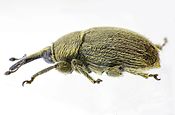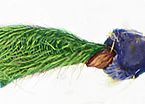Woolwort bile weevil
| Woolwort bile weevil | ||||||||||||
|---|---|---|---|---|---|---|---|---|---|---|---|---|

Woolly bile weevil Rhinusa asellus ♀ |
||||||||||||
| Systematics | ||||||||||||
|
||||||||||||
| Scientific name | ||||||||||||
| Rhinusa asellus | ||||||||||||
| ( Gravenhorst , 1807) |
The woolly billy weevil ( Rhinusa asellus ) is a beetle from the family of weevils . It is most closely related to Rhinusa comosa and belongs to the Rhinusa tetra group of the genus Rhinusa , which as a host plant is restricted to species of the figwort family . Traditionally, Rhinusa is classified as a subgenus of the genus Gymnetron .
Notes on the name
The species was first described in 1807 by Gravenhorst under the name Rhynchaenus asellus as the 47th species of the 159th genus. The description begins with the words: black, with old hair . This explains the species name aséllus ( Latin donkey). The species is now assigned to the genus Rhinusa . The generic name is from, altgr. ρις ρινός "rhis, rhinós" derived for "nose (trunk)".
The little common German name Wollkraut-Gallenrüssler refers to the fact that the larvae on the woolly herb (another name for mullein) cause gall formation.
Properties of the beetle
The length of the beetle, measured without the trunk, varies between four and 5.6 millimeters. The rather compact body is black, but appears gray or yellowish due to the hairiness. The tarsi and antennae are dark brown. The hair is moderately dense, denser on the sides and base of the pronotum, on the shield and along the suture of the wing cover.
In the male, the slender trunk is only slightly longer than the head and pronotum combined. In the female, the trunk is significantly longer, about twice as long as the pronotum. In the female, the trunk tapers slightly in the basal third, seen from above, after which it remains almost the same thickness and is slightly bent downwards in the apical third. In the male, seen from the side, the proboscis tapers slightly and evenly from the base to the tip, hardly seen from above. In addition, the male usually has a small tooth on the underside of the fore thigh in the front third, which is at most indicated in the female. In both sexes, viewed from the side, the forehead forms a straight line with the basal part of the proboscis up to the point where the antennae are deflected (Fig. 2 above); the proboscis is not curved from the base. In front of the antennae it is bare, shiny and very sparse and finely dotted; towards the base it has hair-like scales.
The antennae are in the female just before the middle of the trunk (closer to the base), in the male half the trunk length. The tip of the antenna shaft is thickened like a club. The scourge is five-limbed. The elongated oval antenna lobe is compact. The antenna shaft can be inserted into a sensor pit running in a straight line on the side of the trunk (blue in Fig. 2).
The eyes are on the side of the head. On the upper side, the forehead between the eyes is about as wide as the base of the trunk, not significantly narrower. The throat between the eyes is slightly narrower than the base of the trunk.
The pronotum is about one and a half times as wide as it is long and widest in the basal third. The pronotum is tied off in front. The sides are slightly convex. The pronotum is dense and relatively evenly punctured, between the points it is smooth and shiny.
The elytra are individually rounded at the tip and leave the pygidium uncovered. The latter is usually very hairy. The elytra are moderately rounded, broadest halfway along and together slightly wider than the pronotum. They have eight clear dot stripes (in Fig. 3 partially numbered, the even rows of dots purple, the odd rows tinted green). The third strip is connected to the sixth at the end of the wing-coverts, not the eighth. The eighth is connected to the seventh point strip. The double hairs on the elytra (close-fitting and protruding) run backwards in the front and middle parts of the elytra, transversely in front of the tip of the elytra, and in front of it on the 3rd and 4th interspace whorled (Fig. 3). In rare cases the wing covers are brown except for an area around the label.
The tarsi are all four-part. The first to the third tarsal link are hairy on the underside. The claws are fused at the base. The trochanters do not separate the hip and thigh, but rather lie at the inner angle between the hip and the thigh (Fig. 4).
The underside is usually simply hairy. The front breast is not deepened like a furrow in the middle to accommodate the trunk, but is cut off in a straight line. The front hips are touching. The rear edge of the abdominal sternite is straight to slightly curved, not curved backwards on the sides. The first and second belly asterisks are significantly longer than the following.
Rhinusa asellus differs from the very similar beetle Rhinusa tenuirostris in that it has a longer proboscis and less dense hairs.
biology
Rhenusa asellus prefers warm and dry habitats. The beetle can be found in vineyards, on dry grassland, on dams and on the slopes of opencast mines, as well as on dry ruderal areas .
The species is oligophagous . The larva develops and pupates in different species of the mullein .
The beetles appear after overwintering and feed on the leaves and shoots of the mullein. In northern Ukraine, oviposition begins in June before the host plant blooms. Eggs are preferably laid in the upper parts of the plant. According to another observation, the eggs are laid in sturdy stems of the small-flowered mullein ( Verbascum thapsus ) from about a hand's breadth above the ground to ten centimeters from the end of the stem, with the caterpillars often only having a short distance from one another. The female inserts the proboscis into the plant tissue, creating a round hole. Fig. 5 shows two such holes, the upper one is closed. When the plant reacts, the hole turns black. The eggs are deposited in these holes. They have an unusual, pear-like shape and thus reach a considerable length of 2.6 to 2.7 millimeters. The front part has a diameter of a little over 0.9 millimeters, the rear part, separated by a membrane, a diameter of a little over 0.6 millimeters. Embryonic development takes about a week. The egg is parasitized by Entedon sparetus ( hymenoptera ).
The hatched young larvae eats a round cavity around them, in which they pupate after three larval stages about 3 weeks later. The larvae caves are sometimes directly adjacent to one another. The plant responds by encapsulating the cavity as bile. The infestation is evident through a thickening of the stems (photo). The larvae paper the caves all around with excrement, which makes the caves appear dirty gray-brown. A photo of a section through the galls with larvae is given under the individual records. The larva is very lively and moves jerkily. It is less than twice as long as thick, yellowish-white, matt-glossy and sparingly covered with fine white hairs. It is arched at the top, flattened at the bottom, the head and the end of the body pulled down. The yellow-brown, shiny head has black-brown jaws. Most of the larvae pupate in early August, but newly hatched beetles can also be found in August. The pupa is sparsely haired, the abdomen matt white, the rest of the body shiny yellowish white. However, dolls are still found in November. The beetles appear mainly in September.
One author also mentions the gray cress ( Berteroa incana ) as the host plant , in which the larvae of Rhinusa asellus are supposed to cause the formation of spherical galls in the area of the root neck . However, this is no longer mentioned in more recent work.
distribution
Rhinusa asellus is widespread in Central and Southern Europe, to the east the range extends to central Turkey and the Caucasus states. Left distribution maps of Saxony and the Czech Republic are given under the individual records.
literature
- Heinz joy , Karl Wilhelm Harde , Gustav Adolf Lohse (ed.): The beetles of Central Europe . tape 11 . Rhynchophora (end). Goecke & Evers, Krefeld 1983, ISBN 3-87263-031-8 . P. 267
- Klaus Koch : The Beetles of Central Europe . Ed .: Heinz Freude . tape 3 : ecology . Goecke & Evers, Krefeld 1992, ISBN 3-87263-042-3 . P. 342
Individual evidence
- ↑ Roberto Caldara, Davide Sasso, Ivo Toševski: "Phylogeny of the weevil genus Rhinusa Stephens based on adult morphological characters and host plant information (Coleoptera: Curculionidae)" in Zootaxa 2627: 39-56, 2010 ( PDF, 19 pages on researchgate. net).
- ^ A b Systematics and distribution of Rhinusa asellus in Fauna Europaea
- ^ Johann Ludwig Christian Carl Gravenhorst: Comparative overview of Linneischen and some newer zoological systems Göttingen 1807 preview in the Google book search
- ↑ Sigmund Schenkling: Explanation of the scientific beetle names (species)
- ↑ Sigmund Schenkling: Explanation of the scientific beetle names (genus)
- ↑ A. Hepp: " Gymnetron (Rhinusa) asellus fn rufofusca from the area around Frankfurt (Main) (Coleoptera: Curculionidae)" in Entomologischer Anzeiger Volume XII p. 125, PDF on ZOBODAT
- ^ A b c d Roberto Caldara: " Rhinusa Stephans: a taxonomic revision of the species belonging to the R. tetra and R. bipustulatus groups (Coleoptera, Curculionidae)" in Journal of Insect Biodiversity 2 (19): 1 - 46, 2014 P. 29 ff ( Memento of the original from December 20, 2016 in the Internet Archive ) Info: The archive link was inserted automatically and has not yet been checked. Please check the original and archive link according to the instructions and then remove this notice.
- ↑ a b AV Gumovsky: A taxonomic revision, biology and morphology of immature stages of the Entedon sparetus species group (Hymenoptera: Eulophidae) egg-larval endoparasitoids of weevils (Coleoptera: Curculionidae) in Bulletin of Entomological Research (2007) 97, 139– 166 doi : 10.1017 / S0007485307004798 p. 155
- ↑ a b Rosenhauer: Käfer-Larvae - continuation and conclusion in Entomologische Zeitung 43rd year, No. 4–6, Stettin 1882 p. 132
- ↑ Stem partially peeled mullein with galls, photo
- ↑ Halved stem of the mullein with densely packed galls, pupae and larvae
- ↑ Hugo Schmidt: New Käfergallen from the area of Grünberg Silesia in Societas entomologica 33rd year, No. 8, August 1, 1918 p. 29
- ↑ Distribution map for Saxony
- ↑ Distribution map for the Czech Republic







